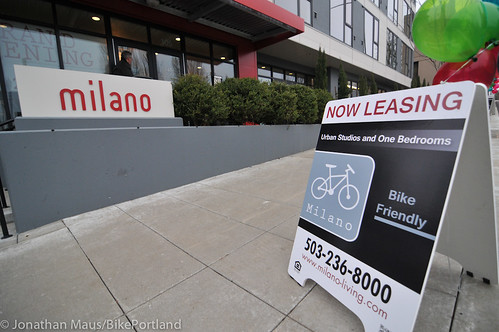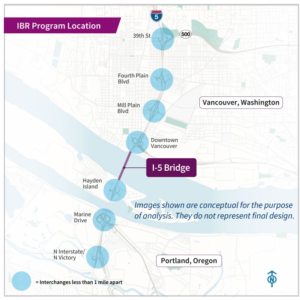
(Photo: J.Maus/BikePortland)
Oregon just got some powerful new voices in support of ending the state’s unusual ban on a type of zoning designed to preserve income-diverse neighborhoods.
It’s a development that could slowly add up to a significant number of new apartments and condos in bikeable, walkable parts of Portland being set aside for lower or middle-income people.
The news was reported late Wednesday by The Oregonian, whose reporter Denis Theriault covered a state Senate hearing in Salem about “inclusionary zoning,” as the policy is known.
Prominent builders and a lobbyist for Oregon real estate agents offered qualified support for lifting the state’s 17-year-old ban on setting housing requirements, also known as inclusionary zoning. Traditionally, those industries have opposed the idea. …
The shift on inclusionary zoning comes months after a similar measure died in the Senate despite passing the House with strong support. It’s even more notable because the new measure up for debate goes beyond the previous bill by adding the state’s rental market.
Democrats and advocates, who’ve made addressing Oregon’s housing crisis a top priority this year, credit a steady drumbeat of stories and statistics meant to illustrate how serious conditions have become. House Democrats are set to preview a major relief package Thursday.
As Theriault notes, the similar bill that unexpectedly failed in the state Senate last year was significantly weaker than the new one: it didn’t include anything to allow the restriction of rental prices, only the prices of initial sales.
“The fact that it’s more powerful gives it more energy, especially from our end,” Justin Buri, executive director of the Community Alliance of Tenants, said Thursday. “It doesn’t leave out — in Oregon I think it’s 43 percent of the population rents. … I think the homebuilders and Realtors are starting to see the writing on the wall and are going to come around.”
If state legislators approve the inclusionary zoning bill in their short legislative session that begins Feb. 1, city councils or other local authorities will need to act to bring the policies into effect. Even then, the policies will only affect newly constructed buildings in parts of the city that have been zoned as such. In the last 10 years, new units in Multnomah County have added up to about 10 percent of its total housing stock. Under the proposed law, no more than 30 percent of those new units could be price-controlled and income-restricted.
Advertisement
Even backers of the measure, like CAT and OPAL Environmental Justice Oregon, have said it’s a partial measure that can’t solve the region’s housing crisis, which saw average multifamily rents across the metro area rise $1,200 last year alone. Over the last 10 years, Multnomah County’s population has grown 79 percent faster than its housing supply.
But backers say an inclusionary zoning law would help — especially as a way to keep income diversity into the most desirable neighborhoods. At least for now, many of those neighborhoods are the ones that offer the best biking, walking and public transit.
“In Milwaukie, as soon as the Orange Line came in, we were starting to hear about evictions and rent increases,” Buri said. “It’s the most vulnerable people who need that access the most.”
CAT is also expecting to support a separate bill in the works from state Rep. Alissa Keny-Guyer (D-Portland) that might require landlords to give reasons for eviction and require more advance notice for rent increases.
As reported by Theriault, the development firm Gerding Edlen, the Oregon Association of Realtors and developer Dike Dame of Williams and Dame all spoke in tentative favor of lifting the inclusionary zoning ban as long as it also included offsetting incentives that could make development cheaper.
Dike Dame, whose firm helped build Portland’s Pearl and South Waterfront districts, said he welcomed the bill because developers have “an obligation” to help tackle housing prices.
He also mentioned San Francisco — but as a place where families can’t afford to live and as an example he’s worried Portland is following.
“We don’t want to be that,” he said.
But Dame also said he appreciated incentives in the bill that would let local governments offer height and density bonuses, fee waivers and speedier permits and applications.
“If there’s something you can get back,” he said, “it’s all about math.”
If this passes in Salem, expect those devilish details to become a major focus for Portland during the April council and mayoral elections and over the next year.
“Portland is getting itself ready to implement some sort of inclusionary zoning program once the state gives the green light,” OPAL Deputy Director Vivian Satterfield said Thursday. “Our leaders are ready to continue testing the waters of what’s possible and what’s legal.”
That’s her takeaway from the appearance of Gerding Edlen and Williams and Dame at Salem’s hearing.
“I ask myself all the time: is it too little, too late?” she added. “But at this point we need every tool in the toolbox. That’s been the refrain from the beginning.”
— Michael Andersen, (503) 333-7824 – michael@bikeportland.org
We’re looking for a corporate sponsor to help fund the Real Estate Beat. Please contact Jonathan Maus jonathan@bikeportland.org for info. You can sign up to get an email of Real Estate Beat posts (and nothing else) here, or read past installments here.






This is great news! However, we must ensure that any plans for affordable housing don’t involve the expansion of the urban growth boundary. I’ve heard some grumblings to that regard from developers. It’s prudent to keep in mind that housing at the car-dependant exurbs is not affordable if it requires the purchase and maintenance of an expensive automobile.
Michael, have you heard about Mayor Hales’ idea to create a new urban renewal district along the Powell-Division BRT line? Word is much of the development would go towards affordable housing.
In addition expansion of urban growth boundary every twenty years or so, and Portland sprawl will continue to swallow the farms, recreation areas, natural areas, and wildlife in this area of the state. Do we plan just to continue expanding Portland indefinitely? That’s a shortsighted way of dealing with more people, not a long term plan.
Agreed, however the UGB was never meant to stop growth, only to limit it. Whether you agree with the requirement to maintain 20 years housing supply is a separate matter. How you define housing supply is also up for debate. Build more R20 sprawl, or build 5-story multi-family housing near public transport? There is plenty of room to densify in the suburbs if we build up, and Metro’s decision not to expand the UGB this year reflects that.
5-story multi-family is sprawl. And the nimbys are still complaining about that. Portland follows the same tired strategy of every other town. Build 5 stories today so you can build 7 stories next year, and 10 stories in a decade. Meanwhile, you’ve wasted ten years and lost countless stories in a direction you knew damn well you were headed all along.
I’ll never concede that growth is a desirable goal, so I guess I should back out of this conversation altogether.
I think what Adam was referring to is the suburban cities who zone their residential land at R-10 or r-20 density, and then claim we should expand the urban growth boundary so they can do more of the same. In that context, 5 stories near transit (Orenco station?) is a more climate-friendly alternative than the typical zoning. Point taken, though.
I have heard a bit about this – thanks for pointing it out. Definitely merits more reporting.
A new urban renewal area would only generate money for affordable housing if a significant amount of new tax-paying development took place. The two eastern URAs that currently exist (Lents Town Center and Gateway Regional Center) haven’t been very successful at spurring new private sector investment. I’m a little skeptical that a Powell-Division URA would fare differently.
What we really need is a citywide property tax levy to fund new affordable housing, similar to the one that’s existed in Seattle since 1981.
Will this happen in Irvington in NE Portland with all those greenways?
Did everyone forget what they learned about supply and demand that they heard about in Econ 101?
Distorting the market by forcing the developers to make some units lower priced will inevitably lead to the property owners increasing the prices of other units so they can cover their costs and make a reasonable profit.
As I’ve suggested before on this forum, if you think developers are making excess profits you have two choices: become a property owner yourself and rent your properties for what you think is a reasonable rent or invest in publicly traded companies (there are homebuilders and real estate investment trusts in which you can own shares for as little as $1000) then use your excess profits to subsidize those who need help.
Additional regulation is very unlikely to help.
I think the evidence on inclusionary zoning is more mixed than you allow.
It’s a little like getting a dog, but wanting one that is friendly with kids and also tracks foxes. It’s possible to get a dog that does those things, it’s possible to get one that doesn’t. It all depends on what kind of dog you get, so to speak.
I wonder how many people who claim to be for affordable housing when it means to them arguing against new development, would switch and argue for new development when that incontrovertibly also supported affordable housing.
I have an idea of the answer (few), but an inclusionary zoning program would put it to the test.
And how many proponents of inclusionary zoning would still support it if you simply called it subsidized housing?
Try reading the facebook group “Stop Demolishing Portland”. Their default reason to be against a development (even where no demolition occurs) is that none of the units are affordable. When a project does contain affordable units (such as Yard or the St Francis Park Apartments, to cite two recent examples) the same people come up with other reasons to dislike the development.
Price controls… what could possibly go wrong?